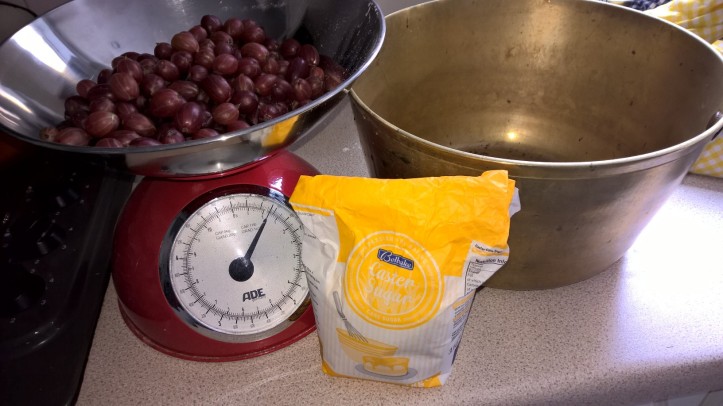We have a lovely neighbour who lives near us, who kindly gives us surplus fruit and vegetables from their allotment. A few weeks ago, near the end of term, she gave us two big bags of gooseberries. I decided it was time to make some jam. I’ve been meaning to write this since the end of July, so here it is. Better late than never!

I delegated the long and tedious task of topping and tailing the gooseberries to the children. Once that was done it was time to make the jam.
I raided the jar cupboard and popped a few suitable jars in the oven on about 100-150C to sterilise. I placed the lids on a tray in the oven too. Then I hunted out my jam recipe book and worked out how much water and sugar I needed for the weight of gooseberries we had. We store potatoes and onions in our maslin pan for 99% of the year, so I gave that a quick clean before putting the fruit and water in. A large heavy-based saucepan would also do. My grandad gave me my maslin pan when he moved into sheltered accommodation. He made amazing jam and his gooseberry jam was particularly good. I like to think a little bit of his jam-making magic survives in this pan.

Jam works best when the fruit isn’t overripe. It is important to simmer the fruit and water gently to soften it and reduce it to a pulp. However, once you add the sugar you should boil it hard and fast. Different fruit varies in the amount of water and sugar needed, so it’s a good idea to find a reliable recipe. I use an old book called ‘Domestic Preservation of Fruits and Vegetables’, which was published in 1946 by the Ministry of Agriculture and Fisheries.


A sugar thermometer can be really handy for working out when the jam reaches setting point. I don’t own one. Instead I put a little mixture on a plate, allow it to cool and then push it with my finger. If it wrinkles, it is at setting point. The only danger with this method is that it is easy to overcook the jam whilst you wait for the sample to cool. I overcooked some plum jam once and was so annoyed with myself that I vowed it wouldn’t happen again. To avoid this happening, I test it on a plate every few minutes. Just as it’s getting near setting point, I take it off the heat whilst I test it. That way, I can pop it back on if it needs a little longer or keep it off the heat if it’s done. I have no idea if this is okay, but it works for me!


I used a wide-neck stainless steel funnel to keep the neck of the jars tidy whilst I ladled the jam in. Then I screwed the lids on and, Robert’s your mother’s brother, we had jam!

Eagle-eyed readers will spot that the children are topping and tailing green gooseberries and the other pictures show red gooseberries. We made two separate batches, one with green and one with red. My dad declared it the best gooseberry jam ever. High praise indeed considering he grew up eating my grandad’s gooseberry jam – it must be the magic maslin pan!